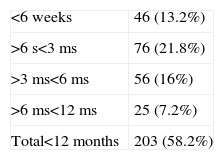In spite of advances in minimally invasive endoscopic surgery, open dismembered pyeloplasty continues to be used in many pediatric centers, especially in small children. The purpose of this work is to present our experience in the performance of this technique using a minimally invasive open pyeloplasty without intrarenal stents.
Material and methodsA retrospective review was made of patients between July 1992 and July 2009. During this time, 348 patients underwent open dismembered pyeloplasty. A total of 310 patients (89%), 223 boys and 87 girls, underwent open pyeloplasty without intrarenal stent. The incision was from 2 to 2.5cm in the flank. An extrarenal drain (3–5 days) and a bladder catheter (<24h) were placed in all patients.
ResultsA total of 319 pyeloplasties were performed without intrarenal catheter in our Service. Of these, 174 (54.5%) were on the left side, 127 (39.8%) on the right side and 9 (5.6%) were bilateral. Age interval was 14 days to 18 years, 58% of the children being younger than 12 months at the time of surgery. With a mean follow-up of 6.7 years (17 years to 11 months), 312 pyeloplasties (97.8%) were successful, with persistence of the obstructive patient in 7 patients who required a new open pyeloplasty (2.2%). Other complications were: prolonged drainage (6), wound infection (1), and urinary infection (2). Mean stay was 22h.
ConclusionsOpen dismembered pyeloplasty is a safe and effective treatment choice for pyeloureteral stenosis in children and can be done without intrarenal stents with no detriment to its success.
A pesar del avance de cirugías mínimamente invasivas, la pieloplastia desmembradaa cielo abierto sigue siendo una cirugía muy utilizada en Pediatría, especialmente en niñospequeños. El propósito de este trabajo es presentar nuestra experiencia en la realización de estatécnica a través de una mínima incisión y sin dejar catéteres intrarrenales transanastomóticos.
Materiales y métodosRevisión retrospectiva desde julio de 1992 a julio de 2009, tiempo en elque 348 pacientes fueron operados de pieloplastia desmembrada a cielo abierto. Un total de310 pacientes (89%), 223 niños y 87 niñas, fueron intervenidos sin dejar catéter intrarrenal. Laincisión fue de 2 a 2,5cm en flanco. En todos los pacientes se dejó drenaje perirrenal y sondavesical, esta última las primeras 24h.
ResultadosEn total se realizaron 319 pieloplastias sin catéteres intrarrenales, 174 (54,5%) dellado izquierdo, 127 (39,8%) del lado derecho y 9 (5,6%) bilaterales. El intervalo de edad fue de14 días a 18 años, siendo el 58% de los niños menor de 12 meses. Con un seguimiento mediode 6,7 años (17 años a 11 meses), 312 pieloplastias (97,8%) fueron realizadas con éxito, conpersistencia del patrón obstructivo en 7 pacientes que precisaron una nueva pieloplastia a cieloabierto (2,2%). Otras complicaciones fueron: drenaje prolongado (6), infección de herida (1) yfiebre/infección urinaria (2). La estancia media fue de 22h.
ConclusionesLa pieloplastia desmembrada a cielo abierto es altamente efectiva en el trata-miento de la estenosis pieloureteral en niños, y prescindir de los catéteres intrarrenales noperjudica su éxito.










